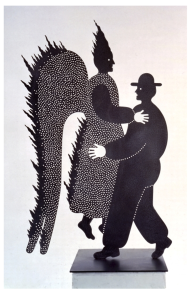The Wrestle in Steel by Grisha Bruskin at the Jewish Museum

Focus. Focus is what you need as you enter the contemporary art section in the Jewish Museum’s permanent collection. In the previous room there is a constant video voice expressing opinions of contemporary Jews concerning a Jewish future. On the right wall there is a black and magenta painting of Barbara Streistand as Yentl, bright and big. On the left, some abstract sculpture. But you must focus on the stainless steel sculpture called The Wrestle right in the middle of the room. A flat cut out silhouette in dull steel. It is hard to see with all this visual and audio background noise and distraction.
Jacob wrestling with the Angel. Jacob as Everyman. With a baggy suit and a funny little hat. An encounter between a human and a divine, each penetrates the other with a chubby hand that is a mirror image of the other. The angel is a flaming winged creature, held up off the ground by Jacob who haltingly steps back.
And Jacob stays in control.
Some art objects operate simply as signs. We can quickly understand the meaning of a sign irrespective of context. A stop sign or a Star of David. Utilitarian objects, Judaica such as a spice box, a menorah or Shabbos candlesticks all operate initially as signs. The meaning is immediate and obvious irrespective of the rich materials used or fineness of craftsmanship. The art of the object is expressed in how the object is made.
A deeper level of meaning is found where images operate as symbols. Symbols have shared meanings that relate to fixed and established concepts residing beyond the artwork itself. A certain kind of hat, depending upon context, can be symbolic of a certain time or type of person.
The addition of other narrative elements to tell a story creates the greatest range of meaning possibilities. Narratives always refer to a specific or implied text or story. The inherent symbolism of most images used to describe a given text opens up an amazing dialogue. Central to the process is the fact that visual works of art normally depict only one or two moments in time while textual narratives occur over a span of time and have a beginning, middle and an end. Therefore the single image depicted ends up ‘speaking’ to and evoking all the other elements of the narrative text. A single image narrates an entire text and creates sets of undiscovered relationships and meanings.
The Wrestle presents us with a unique opportunity to explore these concepts in Jewish art. At first glance, this sculpture is a simple cutout “sign” of Jacob and the Angel. We immediately recognize the upright angel and startled man as the Biblical personages they are.
We now notice, though, that the figures do not match our notion of what Biblical characters should look like. The Angel has a conservative, long, high-necked dress and the man is wearing a suit and hat from our time. Clothing almost always operates primarily as a sign. The rich signal their wealth by their clothing, its style and nowadays, the label. But in the context of this biblical story, the “sign” of their clothing is transformed into a symbol of the contemporary nature of this artwork. Their clothing symbolically announces that this encounter between man and the divine can occur now, in the present time.
Once we are in the symbolic realm the powerful Biblical text starts to interact with the simple image. We notice that the artist has omitted the dramatic conclusion of the hip injury suffered by Jacob, or perhaps has transferred it to the Angel’s hip. We try to match what we know about the text to the anomalies of the image. The playfulness of this sculpture with the spare funny hands speaks to us about what we must share with celestial beings. Even as Jacob steps back, notice how he supports the Angel while being engaged by it. He is almost dancing with this creature. Their mouths are both open; Jacob and the Angel are speaking. While they are at an impasse, Jacob seems in control. The flaming hair and wings and body perforated may distinguish them, but ultimately both man and angel are envisioned in the same cool stainless steel material and on the same two-dimensional plane.
We have voyaged from a simple cut out to a complex meditation on the nature of the divine in our lives. While we wrestle with Divine commands, we can be touched, too. The artist has transformed the text, which speaks of wrestling, into a kind of dance. It seems clear that, while they are shot through by divine light and we are rooted on this earth, both angels and men must dance to one God’s tune.
Grisha Bruskin (American, b. Moscow 1945)
The Wrestle, 1995-1996
Stainless steel sculpture (approx. 3 ½’high, ¼” thick)
Jewish Museum
1109 Fifth Avenue, New York, N.Y.